Business Process Management
VerifiedAdded on 2023/04/07
|17
|3982
|311
AI Summary
This report discusses the concept of Business Process Management and its importance in improving organizational processes. It includes a case study of Swinburne Logistics and identifies the issues in their current system. The report highlights the need for process improvement and automation.
Contribute Materials
Your contribution can guide someone’s learning journey. Share your
documents today.

Running head: BUSINESS PROCESS MANAGEMENT
Business Process Management
Name of the Student:
Name of the University:
Author Note
Business Process Management
Name of the Student:
Name of the University:
Author Note
Secure Best Marks with AI Grader
Need help grading? Try our AI Grader for instant feedback on your assignments.
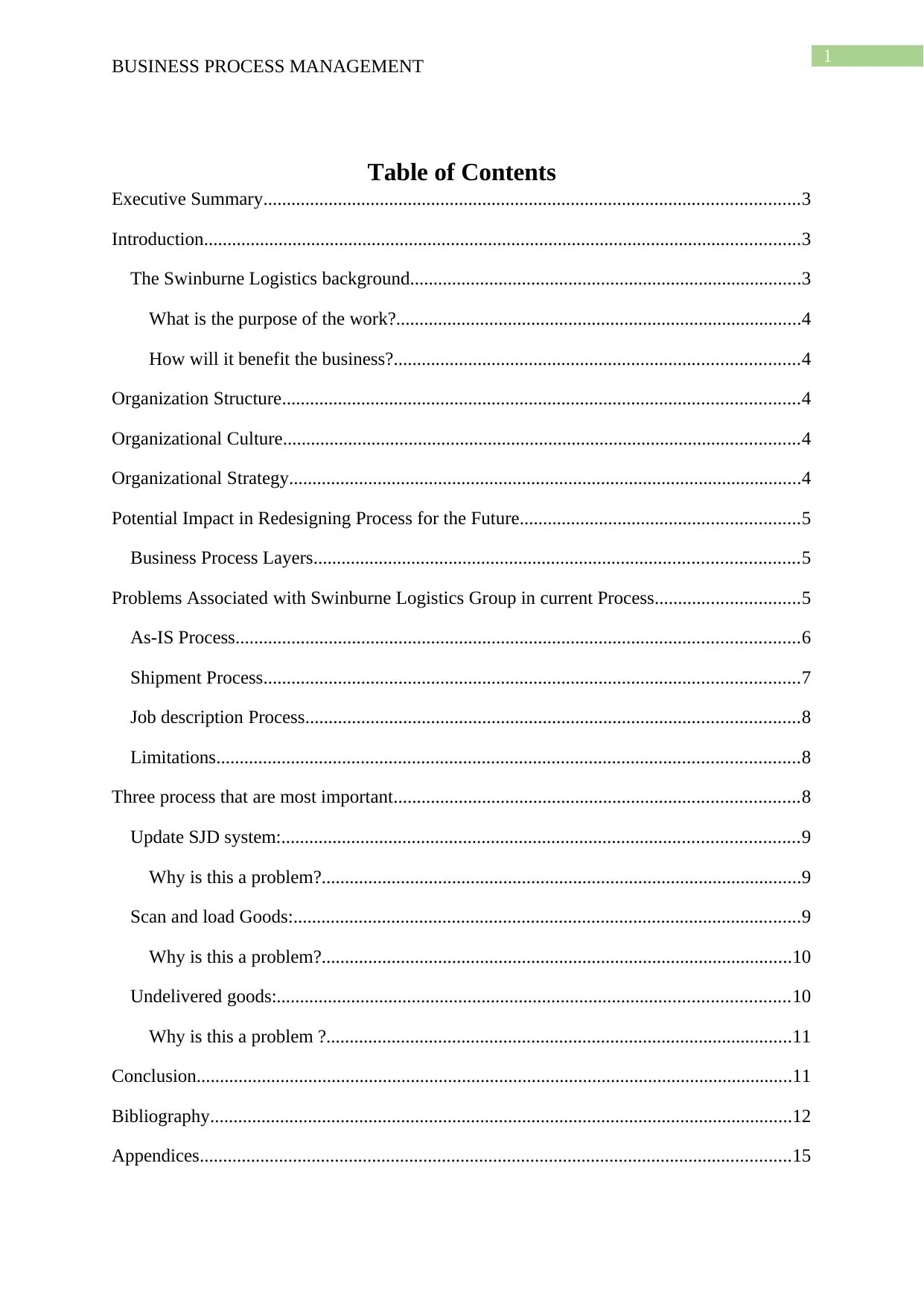
1
BUSINESS PROCESS MANAGEMENT
Table of Contents
Executive Summary...................................................................................................................3
Introduction................................................................................................................................3
The Swinburne Logistics background....................................................................................3
What is the purpose of the work?.......................................................................................4
How will it benefit the business?.......................................................................................4
Organization Structure...............................................................................................................4
Organizational Culture...............................................................................................................4
Organizational Strategy..............................................................................................................4
Potential Impact in Redesigning Process for the Future............................................................5
Business Process Layers........................................................................................................5
Problems Associated with Swinburne Logistics Group in current Process...............................5
As-IS Process.........................................................................................................................6
Shipment Process...................................................................................................................7
Job description Process..........................................................................................................8
Limitations.............................................................................................................................8
Three process that are most important.......................................................................................8
Update SJD system:...............................................................................................................9
Why is this a problem?.......................................................................................................9
Scan and load Goods:.............................................................................................................9
Why is this a problem?.....................................................................................................10
Undelivered goods:..............................................................................................................10
Why is this a problem ?....................................................................................................11
Conclusion................................................................................................................................11
Bibliography.............................................................................................................................12
Appendices...............................................................................................................................15
BUSINESS PROCESS MANAGEMENT
Table of Contents
Executive Summary...................................................................................................................3
Introduction................................................................................................................................3
The Swinburne Logistics background....................................................................................3
What is the purpose of the work?.......................................................................................4
How will it benefit the business?.......................................................................................4
Organization Structure...............................................................................................................4
Organizational Culture...............................................................................................................4
Organizational Strategy..............................................................................................................4
Potential Impact in Redesigning Process for the Future............................................................5
Business Process Layers........................................................................................................5
Problems Associated with Swinburne Logistics Group in current Process...............................5
As-IS Process.........................................................................................................................6
Shipment Process...................................................................................................................7
Job description Process..........................................................................................................8
Limitations.............................................................................................................................8
Three process that are most important.......................................................................................8
Update SJD system:...............................................................................................................9
Why is this a problem?.......................................................................................................9
Scan and load Goods:.............................................................................................................9
Why is this a problem?.....................................................................................................10
Undelivered goods:..............................................................................................................10
Why is this a problem ?....................................................................................................11
Conclusion................................................................................................................................11
Bibliography.............................................................................................................................12
Appendices...............................................................................................................................15

2
BUSINESS PROCESS MANAGEMENT
As-Is Process........................................................................................................................15
Shipment Process.................................................................................................................16
Job Distribution Process.......................................................................................................16
BUSINESS PROCESS MANAGEMENT
As-Is Process........................................................................................................................15
Shipment Process.................................................................................................................16
Job Distribution Process.......................................................................................................16
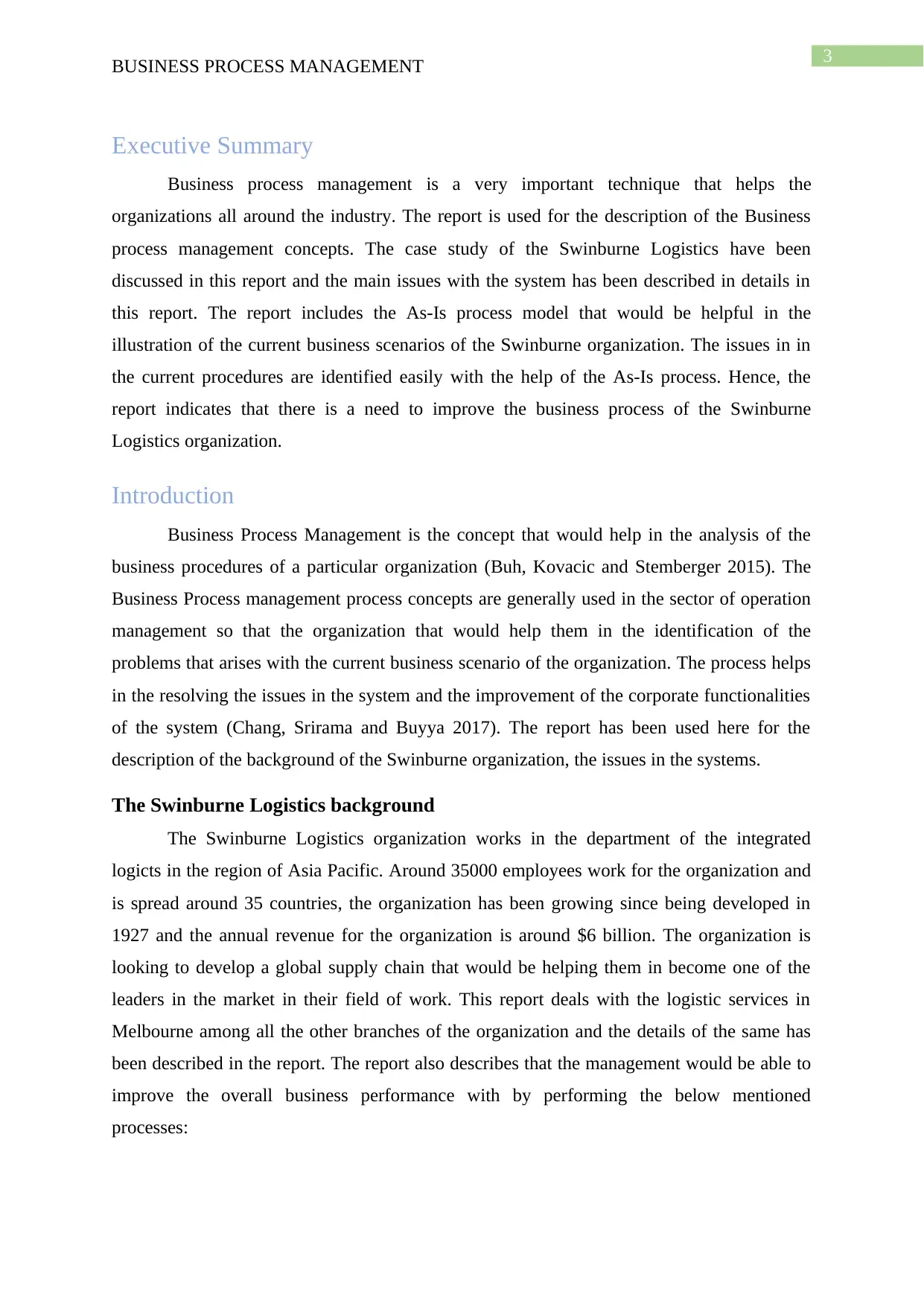
3
BUSINESS PROCESS MANAGEMENT
Executive Summary
Business process management is a very important technique that helps the
organizations all around the industry. The report is used for the description of the Business
process management concepts. The case study of the Swinburne Logistics have been
discussed in this report and the main issues with the system has been described in details in
this report. The report includes the As-Is process model that would be helpful in the
illustration of the current business scenarios of the Swinburne organization. The issues in in
the current procedures are identified easily with the help of the As-Is process. Hence, the
report indicates that there is a need to improve the business process of the Swinburne
Logistics organization.
Introduction
Business Process Management is the concept that would help in the analysis of the
business procedures of a particular organization (Buh, Kovacic and Stemberger 2015). The
Business Process management process concepts are generally used in the sector of operation
management so that the organization that would help them in the identification of the
problems that arises with the current business scenario of the organization. The process helps
in the resolving the issues in the system and the improvement of the corporate functionalities
of the system (Chang, Srirama and Buyya 2017). The report has been used here for the
description of the background of the Swinburne organization, the issues in the systems.
The Swinburne Logistics background
The Swinburne Logistics organization works in the department of the integrated
logicts in the region of Asia Pacific. Around 35000 employees work for the organization and
is spread around 35 countries, the organization has been growing since being developed in
1927 and the annual revenue for the organization is around $6 billion. The organization is
looking to develop a global supply chain that would be helping them in become one of the
leaders in the market in their field of work. This report deals with the logistic services in
Melbourne among all the other branches of the organization and the details of the same has
been described in the report. The report also describes that the management would be able to
improve the overall business performance with by performing the below mentioned
processes:
BUSINESS PROCESS MANAGEMENT
Executive Summary
Business process management is a very important technique that helps the
organizations all around the industry. The report is used for the description of the Business
process management concepts. The case study of the Swinburne Logistics have been
discussed in this report and the main issues with the system has been described in details in
this report. The report includes the As-Is process model that would be helpful in the
illustration of the current business scenarios of the Swinburne organization. The issues in in
the current procedures are identified easily with the help of the As-Is process. Hence, the
report indicates that there is a need to improve the business process of the Swinburne
Logistics organization.
Introduction
Business Process Management is the concept that would help in the analysis of the
business procedures of a particular organization (Buh, Kovacic and Stemberger 2015). The
Business Process management process concepts are generally used in the sector of operation
management so that the organization that would help them in the identification of the
problems that arises with the current business scenario of the organization. The process helps
in the resolving the issues in the system and the improvement of the corporate functionalities
of the system (Chang, Srirama and Buyya 2017). The report has been used here for the
description of the background of the Swinburne organization, the issues in the systems.
The Swinburne Logistics background
The Swinburne Logistics organization works in the department of the integrated
logicts in the region of Asia Pacific. Around 35000 employees work for the organization and
is spread around 35 countries, the organization has been growing since being developed in
1927 and the annual revenue for the organization is around $6 billion. The organization is
looking to develop a global supply chain that would be helping them in become one of the
leaders in the market in their field of work. This report deals with the logistic services in
Melbourne among all the other branches of the organization and the details of the same has
been described in the report. The report also describes that the management would be able to
improve the overall business performance with by performing the below mentioned
processes:
Secure Best Marks with AI Grader
Need help grading? Try our AI Grader for instant feedback on your assignments.
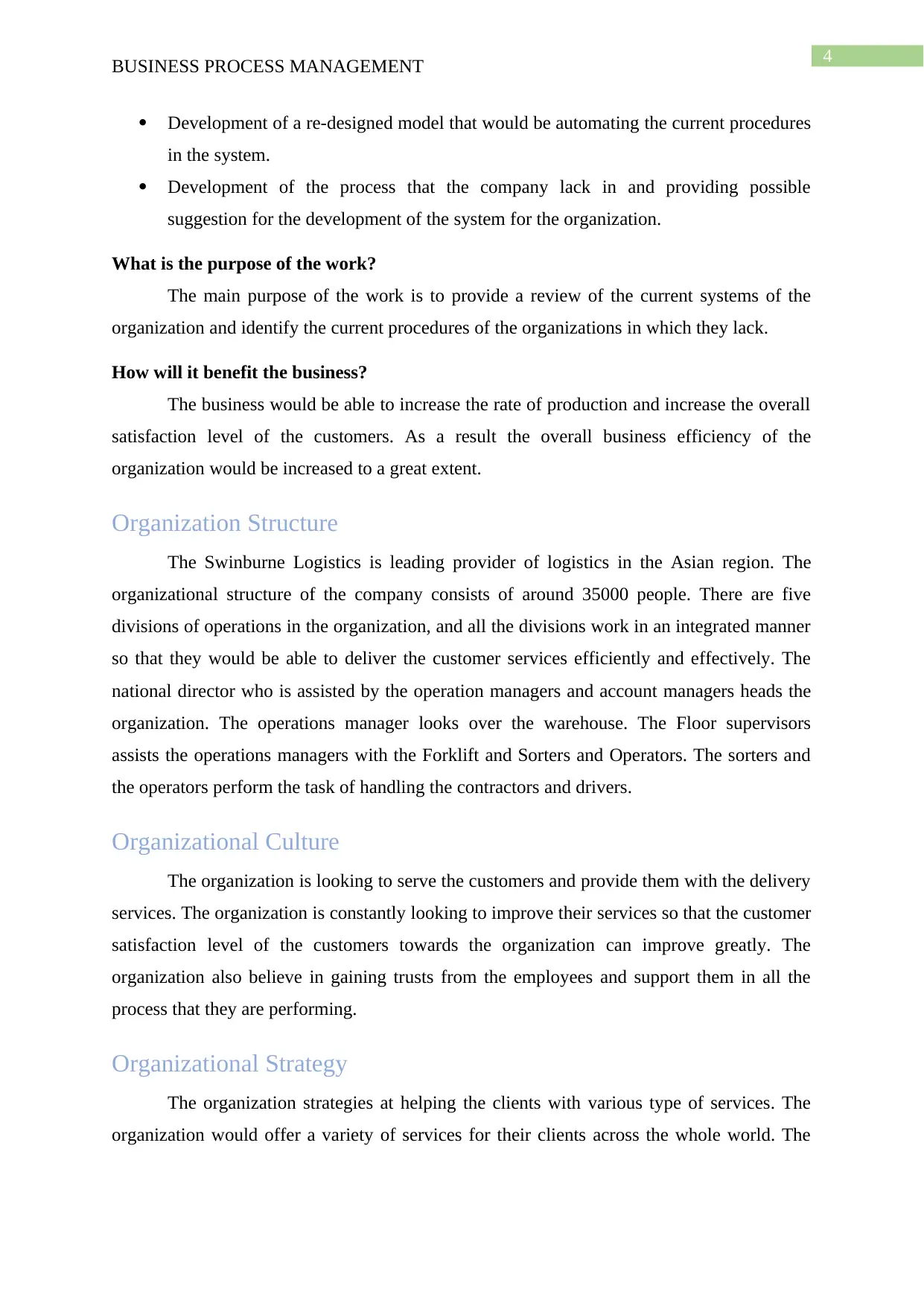
4
BUSINESS PROCESS MANAGEMENT
Development of a re-designed model that would be automating the current procedures
in the system.
Development of the process that the company lack in and providing possible
suggestion for the development of the system for the organization.
What is the purpose of the work?
The main purpose of the work is to provide a review of the current systems of the
organization and identify the current procedures of the organizations in which they lack.
How will it benefit the business?
The business would be able to increase the rate of production and increase the overall
satisfaction level of the customers. As a result the overall business efficiency of the
organization would be increased to a great extent.
Organization Structure
The Swinburne Logistics is leading provider of logistics in the Asian region. The
organizational structure of the company consists of around 35000 people. There are five
divisions of operations in the organization, and all the divisions work in an integrated manner
so that they would be able to deliver the customer services efficiently and effectively. The
national director who is assisted by the operation managers and account managers heads the
organization. The operations manager looks over the warehouse. The Floor supervisors
assists the operations managers with the Forklift and Sorters and Operators. The sorters and
the operators perform the task of handling the contractors and drivers.
Organizational Culture
The organization is looking to serve the customers and provide them with the delivery
services. The organization is constantly looking to improve their services so that the customer
satisfaction level of the customers towards the organization can improve greatly. The
organization also believe in gaining trusts from the employees and support them in all the
process that they are performing.
Organizational Strategy
The organization strategies at helping the clients with various type of services. The
organization would offer a variety of services for their clients across the whole world. The
BUSINESS PROCESS MANAGEMENT
Development of a re-designed model that would be automating the current procedures
in the system.
Development of the process that the company lack in and providing possible
suggestion for the development of the system for the organization.
What is the purpose of the work?
The main purpose of the work is to provide a review of the current systems of the
organization and identify the current procedures of the organizations in which they lack.
How will it benefit the business?
The business would be able to increase the rate of production and increase the overall
satisfaction level of the customers. As a result the overall business efficiency of the
organization would be increased to a great extent.
Organization Structure
The Swinburne Logistics is leading provider of logistics in the Asian region. The
organizational structure of the company consists of around 35000 people. There are five
divisions of operations in the organization, and all the divisions work in an integrated manner
so that they would be able to deliver the customer services efficiently and effectively. The
national director who is assisted by the operation managers and account managers heads the
organization. The operations manager looks over the warehouse. The Floor supervisors
assists the operations managers with the Forklift and Sorters and Operators. The sorters and
the operators perform the task of handling the contractors and drivers.
Organizational Culture
The organization is looking to serve the customers and provide them with the delivery
services. The organization is constantly looking to improve their services so that the customer
satisfaction level of the customers towards the organization can improve greatly. The
organization also believe in gaining trusts from the employees and support them in all the
process that they are performing.
Organizational Strategy
The organization strategies at helping the clients with various type of services. The
organization would offer a variety of services for their clients across the whole world. The
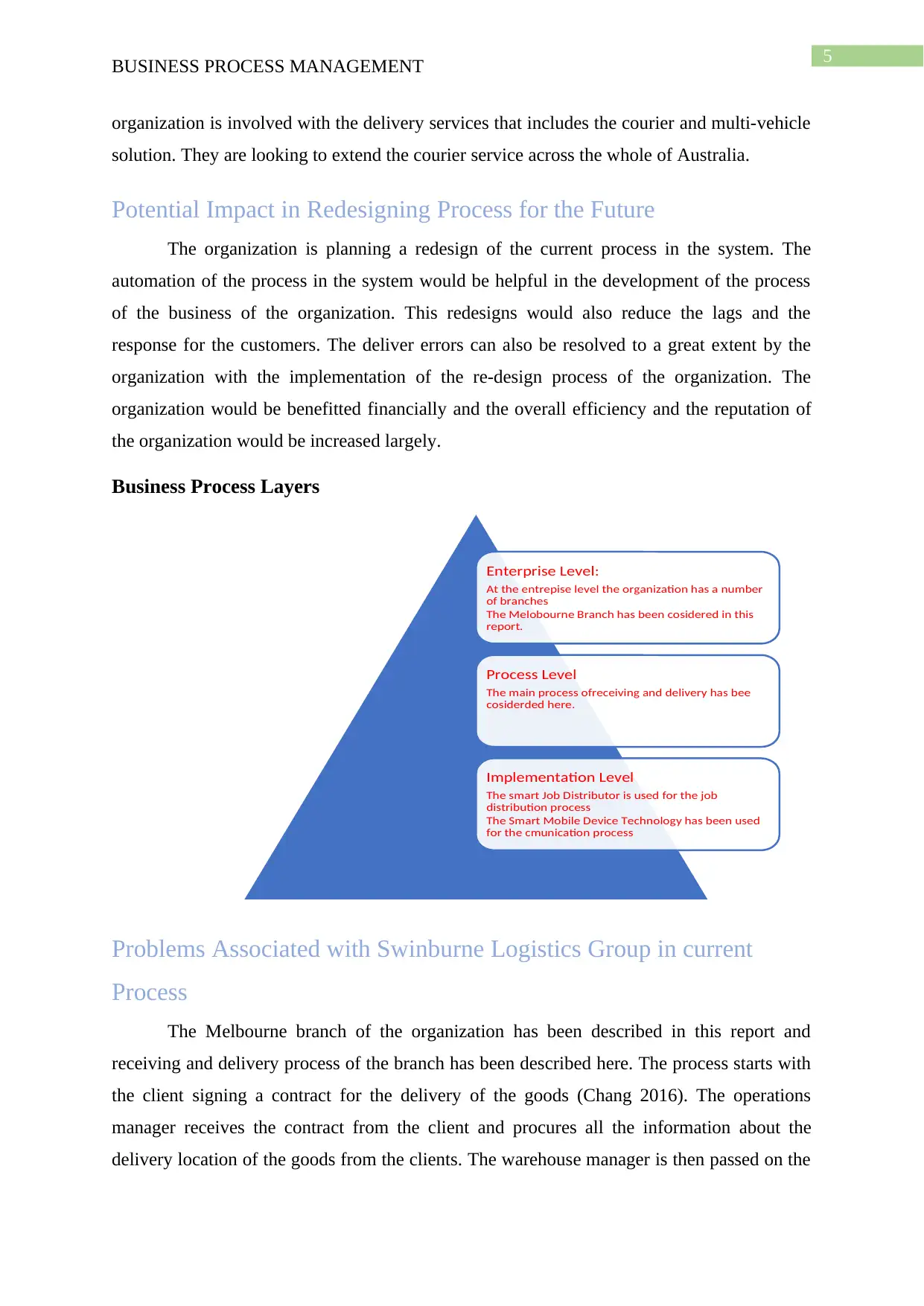
5
BUSINESS PROCESS MANAGEMENT
organization is involved with the delivery services that includes the courier and multi-vehicle
solution. They are looking to extend the courier service across the whole of Australia.
Potential Impact in Redesigning Process for the Future
The organization is planning a redesign of the current process in the system. The
automation of the process in the system would be helpful in the development of the process
of the business of the organization. This redesigns would also reduce the lags and the
response for the customers. The deliver errors can also be resolved to a great extent by the
organization with the implementation of the re-design process of the organization. The
organization would be benefitted financially and the overall efficiency and the reputation of
the organization would be increased largely.
Business Process Layers
Problems Associated with Swinburne Logistics Group in current
Process
The Melbourne branch of the organization has been described in this report and
receiving and delivery process of the branch has been described here. The process starts with
the client signing a contract for the delivery of the goods (Chang 2016). The operations
manager receives the contract from the client and procures all the information about the
delivery location of the goods from the clients. The warehouse manager is then passed on the
Enterprise Level:
At the entrepise level the organization has a number
of branches
The Melobourne Branch has been cosidered in this
report.
Process Level
The main process ofreceiving and delivery has bee
cosiderded here.
Implementation Level
The smart Job Distributor is used for the job
distribution process
The Smart Mobile Device Technology has been used
for the cmunication process
BUSINESS PROCESS MANAGEMENT
organization is involved with the delivery services that includes the courier and multi-vehicle
solution. They are looking to extend the courier service across the whole of Australia.
Potential Impact in Redesigning Process for the Future
The organization is planning a redesign of the current process in the system. The
automation of the process in the system would be helpful in the development of the process
of the business of the organization. This redesigns would also reduce the lags and the
response for the customers. The deliver errors can also be resolved to a great extent by the
organization with the implementation of the re-design process of the organization. The
organization would be benefitted financially and the overall efficiency and the reputation of
the organization would be increased largely.
Business Process Layers
Problems Associated with Swinburne Logistics Group in current
Process
The Melbourne branch of the organization has been described in this report and
receiving and delivery process of the branch has been described here. The process starts with
the client signing a contract for the delivery of the goods (Chang 2016). The operations
manager receives the contract from the client and procures all the information about the
delivery location of the goods from the clients. The warehouse manager is then passed on the
Enterprise Level:
At the entrepise level the organization has a number
of branches
The Melobourne Branch has been cosidered in this
report.
Process Level
The main process ofreceiving and delivery has bee
cosiderded here.
Implementation Level
The smart Job Distributor is used for the job
distribution process
The Smart Mobile Device Technology has been used
for the cmunication process
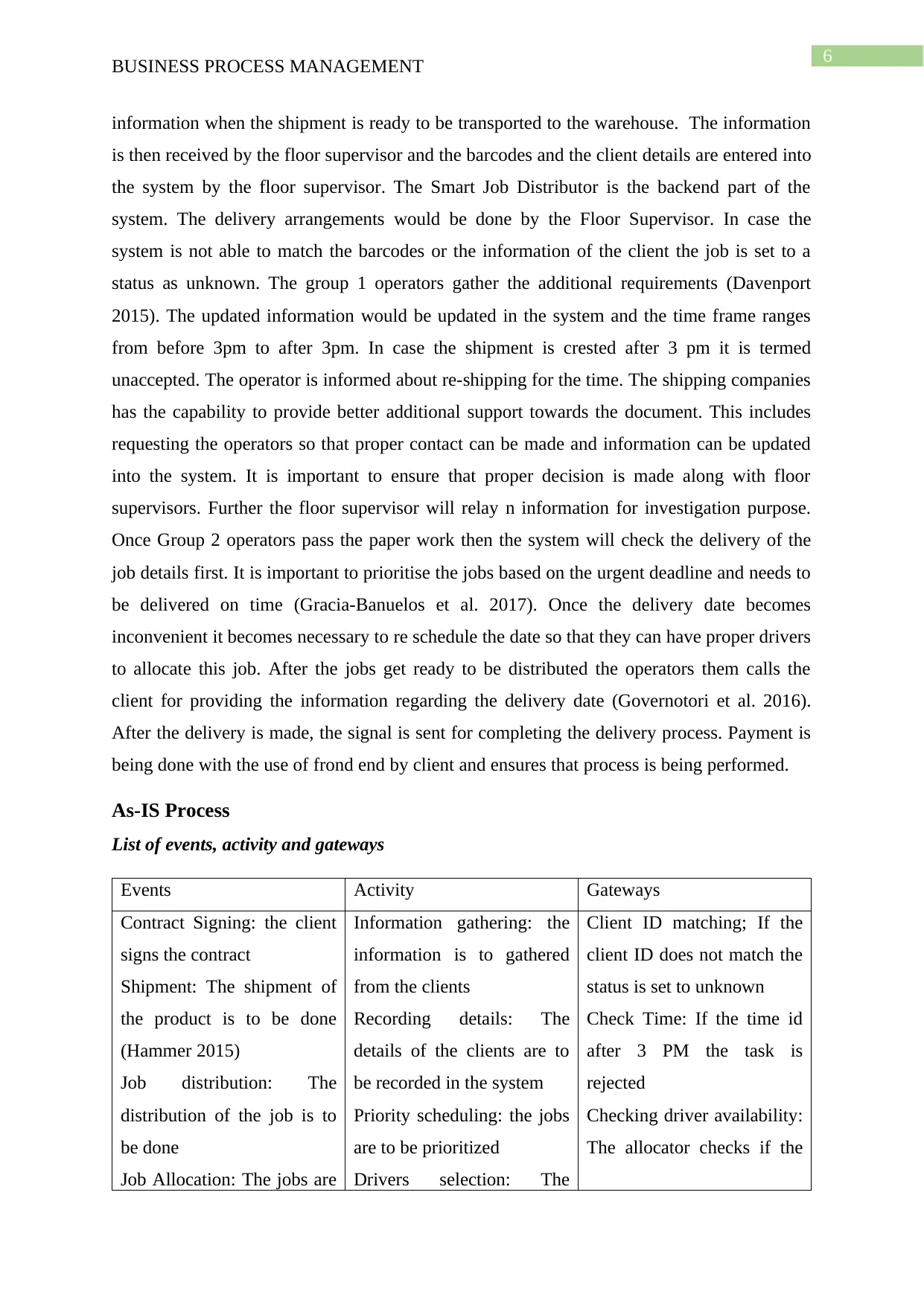
6
BUSINESS PROCESS MANAGEMENT
information when the shipment is ready to be transported to the warehouse. The information
is then received by the floor supervisor and the barcodes and the client details are entered into
the system by the floor supervisor. The Smart Job Distributor is the backend part of the
system. The delivery arrangements would be done by the Floor Supervisor. In case the
system is not able to match the barcodes or the information of the client the job is set to a
status as unknown. The group 1 operators gather the additional requirements (Davenport
2015). The updated information would be updated in the system and the time frame ranges
from before 3pm to after 3pm. In case the shipment is crested after 3 pm it is termed
unaccepted. The operator is informed about re-shipping for the time. The shipping companies
has the capability to provide better additional support towards the document. This includes
requesting the operators so that proper contact can be made and information can be updated
into the system. It is important to ensure that proper decision is made along with floor
supervisors. Further the floor supervisor will relay n information for investigation purpose.
Once Group 2 operators pass the paper work then the system will check the delivery of the
job details first. It is important to prioritise the jobs based on the urgent deadline and needs to
be delivered on time (Gracia-Banuelos et al. 2017). Once the delivery date becomes
inconvenient it becomes necessary to re schedule the date so that they can have proper drivers
to allocate this job. After the jobs get ready to be distributed the operators them calls the
client for providing the information regarding the delivery date (Governotori et al. 2016).
After the delivery is made, the signal is sent for completing the delivery process. Payment is
being done with the use of frond end by client and ensures that process is being performed.
As-IS Process
List of events, activity and gateways
Events Activity Gateways
Contract Signing: the client
signs the contract
Shipment: The shipment of
the product is to be done
(Hammer 2015)
Job distribution: The
distribution of the job is to
be done
Job Allocation: The jobs are
Information gathering: the
information is to gathered
from the clients
Recording details: The
details of the clients are to
be recorded in the system
Priority scheduling: the jobs
are to be prioritized
Drivers selection: The
Client ID matching; If the
client ID does not match the
status is set to unknown
Check Time: If the time id
after 3 PM the task is
rejected
Checking driver availability:
The allocator checks if the
BUSINESS PROCESS MANAGEMENT
information when the shipment is ready to be transported to the warehouse. The information
is then received by the floor supervisor and the barcodes and the client details are entered into
the system by the floor supervisor. The Smart Job Distributor is the backend part of the
system. The delivery arrangements would be done by the Floor Supervisor. In case the
system is not able to match the barcodes or the information of the client the job is set to a
status as unknown. The group 1 operators gather the additional requirements (Davenport
2015). The updated information would be updated in the system and the time frame ranges
from before 3pm to after 3pm. In case the shipment is crested after 3 pm it is termed
unaccepted. The operator is informed about re-shipping for the time. The shipping companies
has the capability to provide better additional support towards the document. This includes
requesting the operators so that proper contact can be made and information can be updated
into the system. It is important to ensure that proper decision is made along with floor
supervisors. Further the floor supervisor will relay n information for investigation purpose.
Once Group 2 operators pass the paper work then the system will check the delivery of the
job details first. It is important to prioritise the jobs based on the urgent deadline and needs to
be delivered on time (Gracia-Banuelos et al. 2017). Once the delivery date becomes
inconvenient it becomes necessary to re schedule the date so that they can have proper drivers
to allocate this job. After the jobs get ready to be distributed the operators them calls the
client for providing the information regarding the delivery date (Governotori et al. 2016).
After the delivery is made, the signal is sent for completing the delivery process. Payment is
being done with the use of frond end by client and ensures that process is being performed.
As-IS Process
List of events, activity and gateways
Events Activity Gateways
Contract Signing: the client
signs the contract
Shipment: The shipment of
the product is to be done
(Hammer 2015)
Job distribution: The
distribution of the job is to
be done
Job Allocation: The jobs are
Information gathering: the
information is to gathered
from the clients
Recording details: The
details of the clients are to
be recorded in the system
Priority scheduling: the jobs
are to be prioritized
Drivers selection: The
Client ID matching; If the
client ID does not match the
status is set to unknown
Check Time: If the time id
after 3 PM the task is
rejected
Checking driver availability:
The allocator checks if the
Paraphrase This Document
Need a fresh take? Get an instant paraphrase of this document with our AI Paraphraser
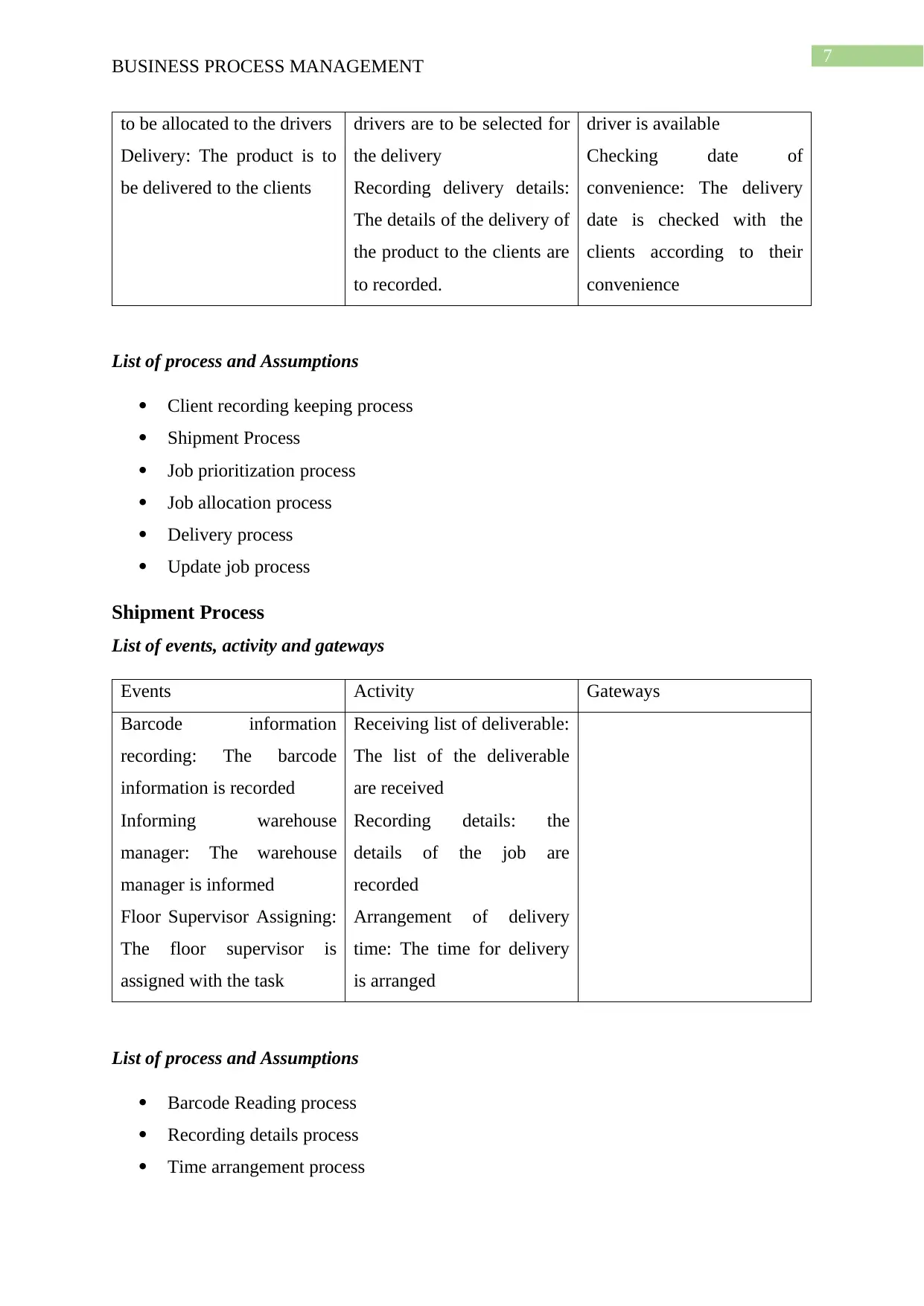
7
BUSINESS PROCESS MANAGEMENT
to be allocated to the drivers
Delivery: The product is to
be delivered to the clients
drivers are to be selected for
the delivery
Recording delivery details:
The details of the delivery of
the product to the clients are
to recorded.
driver is available
Checking date of
convenience: The delivery
date is checked with the
clients according to their
convenience
List of process and Assumptions
Client recording keeping process
Shipment Process
Job prioritization process
Job allocation process
Delivery process
Update job process
Shipment Process
List of events, activity and gateways
Events Activity Gateways
Barcode information
recording: The barcode
information is recorded
Informing warehouse
manager: The warehouse
manager is informed
Floor Supervisor Assigning:
The floor supervisor is
assigned with the task
Receiving list of deliverable:
The list of the deliverable
are received
Recording details: the
details of the job are
recorded
Arrangement of delivery
time: The time for delivery
is arranged
List of process and Assumptions
Barcode Reading process
Recording details process
Time arrangement process
BUSINESS PROCESS MANAGEMENT
to be allocated to the drivers
Delivery: The product is to
be delivered to the clients
drivers are to be selected for
the delivery
Recording delivery details:
The details of the delivery of
the product to the clients are
to recorded.
driver is available
Checking date of
convenience: The delivery
date is checked with the
clients according to their
convenience
List of process and Assumptions
Client recording keeping process
Shipment Process
Job prioritization process
Job allocation process
Delivery process
Update job process
Shipment Process
List of events, activity and gateways
Events Activity Gateways
Barcode information
recording: The barcode
information is recorded
Informing warehouse
manager: The warehouse
manager is informed
Floor Supervisor Assigning:
The floor supervisor is
assigned with the task
Receiving list of deliverable:
The list of the deliverable
are received
Recording details: the
details of the job are
recorded
Arrangement of delivery
time: The time for delivery
is arranged
List of process and Assumptions
Barcode Reading process
Recording details process
Time arrangement process
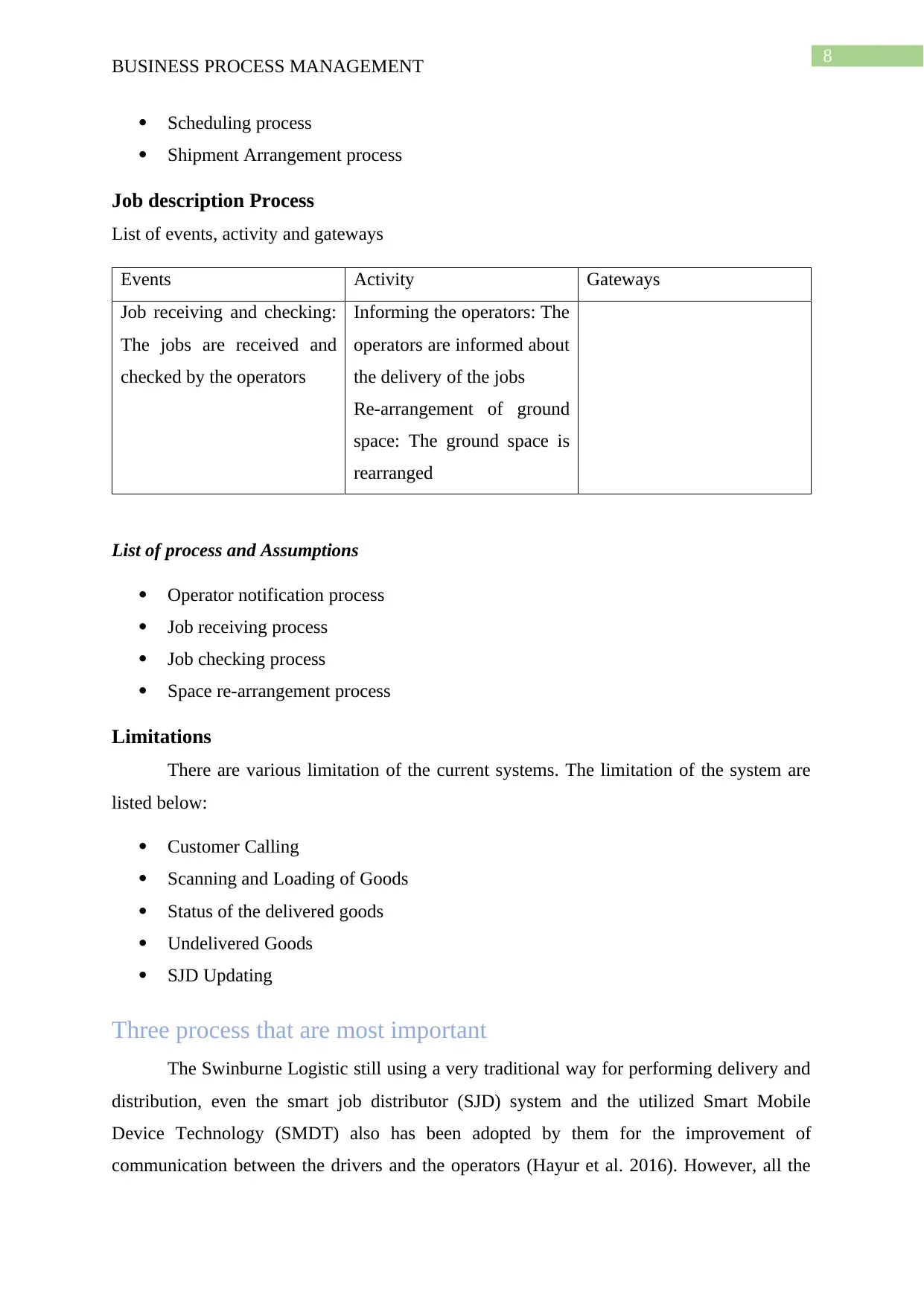
8
BUSINESS PROCESS MANAGEMENT
Scheduling process
Shipment Arrangement process
Job description Process
List of events, activity and gateways
Events Activity Gateways
Job receiving and checking:
The jobs are received and
checked by the operators
Informing the operators: The
operators are informed about
the delivery of the jobs
Re-arrangement of ground
space: The ground space is
rearranged
List of process and Assumptions
Operator notification process
Job receiving process
Job checking process
Space re-arrangement process
Limitations
There are various limitation of the current systems. The limitation of the system are
listed below:
Customer Calling
Scanning and Loading of Goods
Status of the delivered goods
Undelivered Goods
SJD Updating
Three process that are most important
The Swinburne Logistic still using a very traditional way for performing delivery and
distribution, even the smart job distributor (SJD) system and the utilized Smart Mobile
Device Technology (SMDT) also has been adopted by them for the improvement of
communication between the drivers and the operators (Hayur et al. 2016). However, all the
BUSINESS PROCESS MANAGEMENT
Scheduling process
Shipment Arrangement process
Job description Process
List of events, activity and gateways
Events Activity Gateways
Job receiving and checking:
The jobs are received and
checked by the operators
Informing the operators: The
operators are informed about
the delivery of the jobs
Re-arrangement of ground
space: The ground space is
rearranged
List of process and Assumptions
Operator notification process
Job receiving process
Job checking process
Space re-arrangement process
Limitations
There are various limitation of the current systems. The limitation of the system are
listed below:
Customer Calling
Scanning and Loading of Goods
Status of the delivered goods
Undelivered Goods
SJD Updating
Three process that are most important
The Swinburne Logistic still using a very traditional way for performing delivery and
distribution, even the smart job distributor (SJD) system and the utilized Smart Mobile
Device Technology (SMDT) also has been adopted by them for the improvement of
communication between the drivers and the operators (Hayur et al. 2016). However, all the
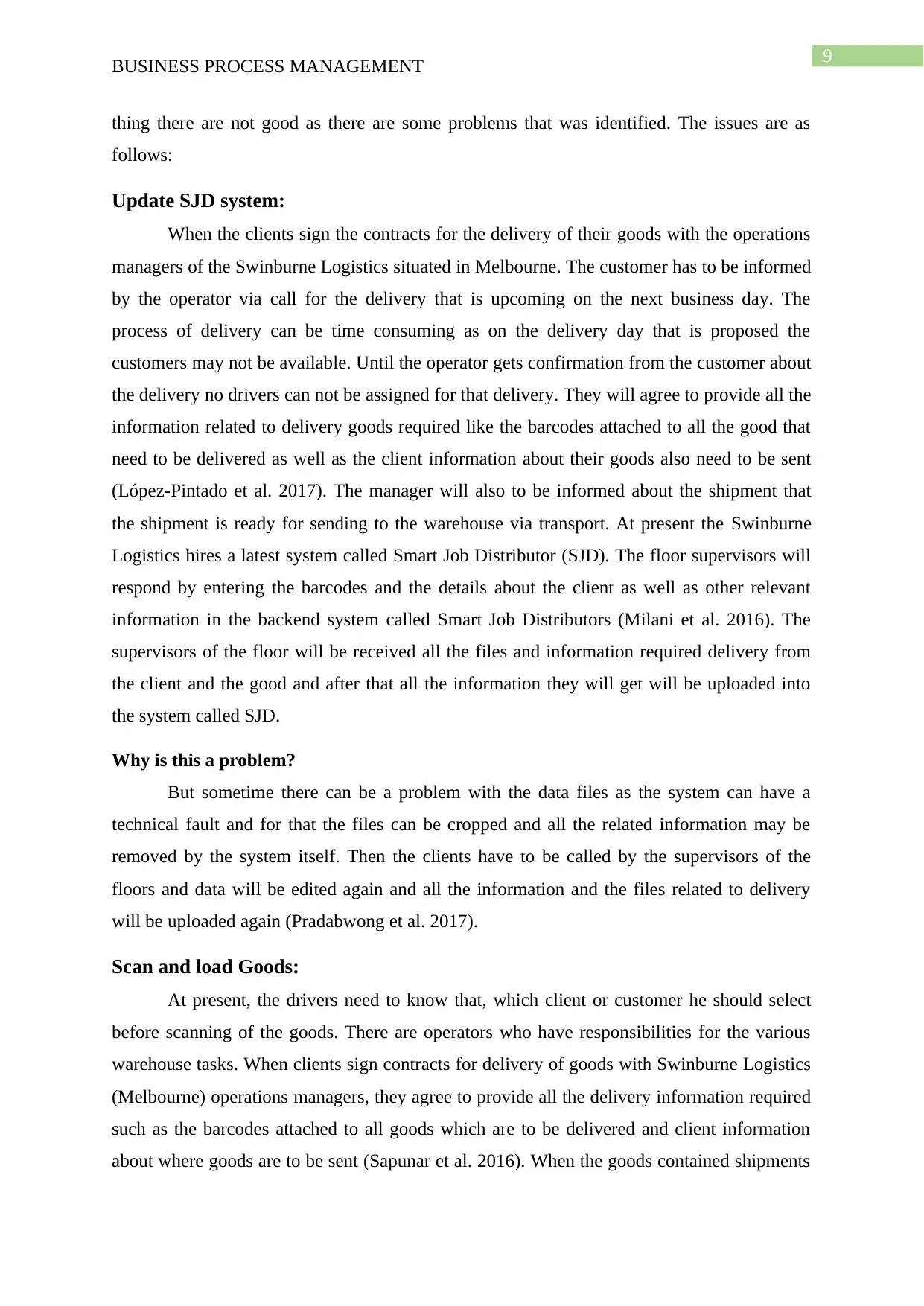
9
BUSINESS PROCESS MANAGEMENT
thing there are not good as there are some problems that was identified. The issues are as
follows:
Update SJD system:
When the clients sign the contracts for the delivery of their goods with the operations
managers of the Swinburne Logistics situated in Melbourne. The customer has to be informed
by the operator via call for the delivery that is upcoming on the next business day. The
process of delivery can be time consuming as on the delivery day that is proposed the
customers may not be available. Until the operator gets confirmation from the customer about
the delivery no drivers can not be assigned for that delivery. They will agree to provide all the
information related to delivery goods required like the barcodes attached to all the good that
need to be delivered as well as the client information about their goods also need to be sent
(López-Pintado et al. 2017). The manager will also to be informed about the shipment that
the shipment is ready for sending to the warehouse via transport. At present the Swinburne
Logistics hires a latest system called Smart Job Distributor (SJD). The floor supervisors will
respond by entering the barcodes and the details about the client as well as other relevant
information in the backend system called Smart Job Distributors (Milani et al. 2016). The
supervisors of the floor will be received all the files and information required delivery from
the client and the good and after that all the information they will get will be uploaded into
the system called SJD.
Why is this a problem?
But sometime there can be a problem with the data files as the system can have a
technical fault and for that the files can be cropped and all the related information may be
removed by the system itself. Then the clients have to be called by the supervisors of the
floors and data will be edited again and all the information and the files related to delivery
will be uploaded again (Pradabwong et al. 2017).
Scan and load Goods:
At present, the drivers need to know that, which client or customer he should select
before scanning of the goods. There are operators who have responsibilities for the various
warehouse tasks. When clients sign contracts for delivery of goods with Swinburne Logistics
(Melbourne) operations managers, they agree to provide all the delivery information required
such as the barcodes attached to all goods which are to be delivered and client information
about where goods are to be sent (Sapunar et al. 2016). When the goods contained shipments
BUSINESS PROCESS MANAGEMENT
thing there are not good as there are some problems that was identified. The issues are as
follows:
Update SJD system:
When the clients sign the contracts for the delivery of their goods with the operations
managers of the Swinburne Logistics situated in Melbourne. The customer has to be informed
by the operator via call for the delivery that is upcoming on the next business day. The
process of delivery can be time consuming as on the delivery day that is proposed the
customers may not be available. Until the operator gets confirmation from the customer about
the delivery no drivers can not be assigned for that delivery. They will agree to provide all the
information related to delivery goods required like the barcodes attached to all the good that
need to be delivered as well as the client information about their goods also need to be sent
(López-Pintado et al. 2017). The manager will also to be informed about the shipment that
the shipment is ready for sending to the warehouse via transport. At present the Swinburne
Logistics hires a latest system called Smart Job Distributor (SJD). The floor supervisors will
respond by entering the barcodes and the details about the client as well as other relevant
information in the backend system called Smart Job Distributors (Milani et al. 2016). The
supervisors of the floor will be received all the files and information required delivery from
the client and the good and after that all the information they will get will be uploaded into
the system called SJD.
Why is this a problem?
But sometime there can be a problem with the data files as the system can have a
technical fault and for that the files can be cropped and all the related information may be
removed by the system itself. Then the clients have to be called by the supervisors of the
floors and data will be edited again and all the information and the files related to delivery
will be uploaded again (Pradabwong et al. 2017).
Scan and load Goods:
At present, the drivers need to know that, which client or customer he should select
before scanning of the goods. There are operators who have responsibilities for the various
warehouse tasks. When clients sign contracts for delivery of goods with Swinburne Logistics
(Melbourne) operations managers, they agree to provide all the delivery information required
such as the barcodes attached to all goods which are to be delivered and client information
about where goods are to be sent (Sapunar et al. 2016). When the goods contained shipments
Secure Best Marks with AI Grader
Need help grading? Try our AI Grader for instant feedback on your assignments.
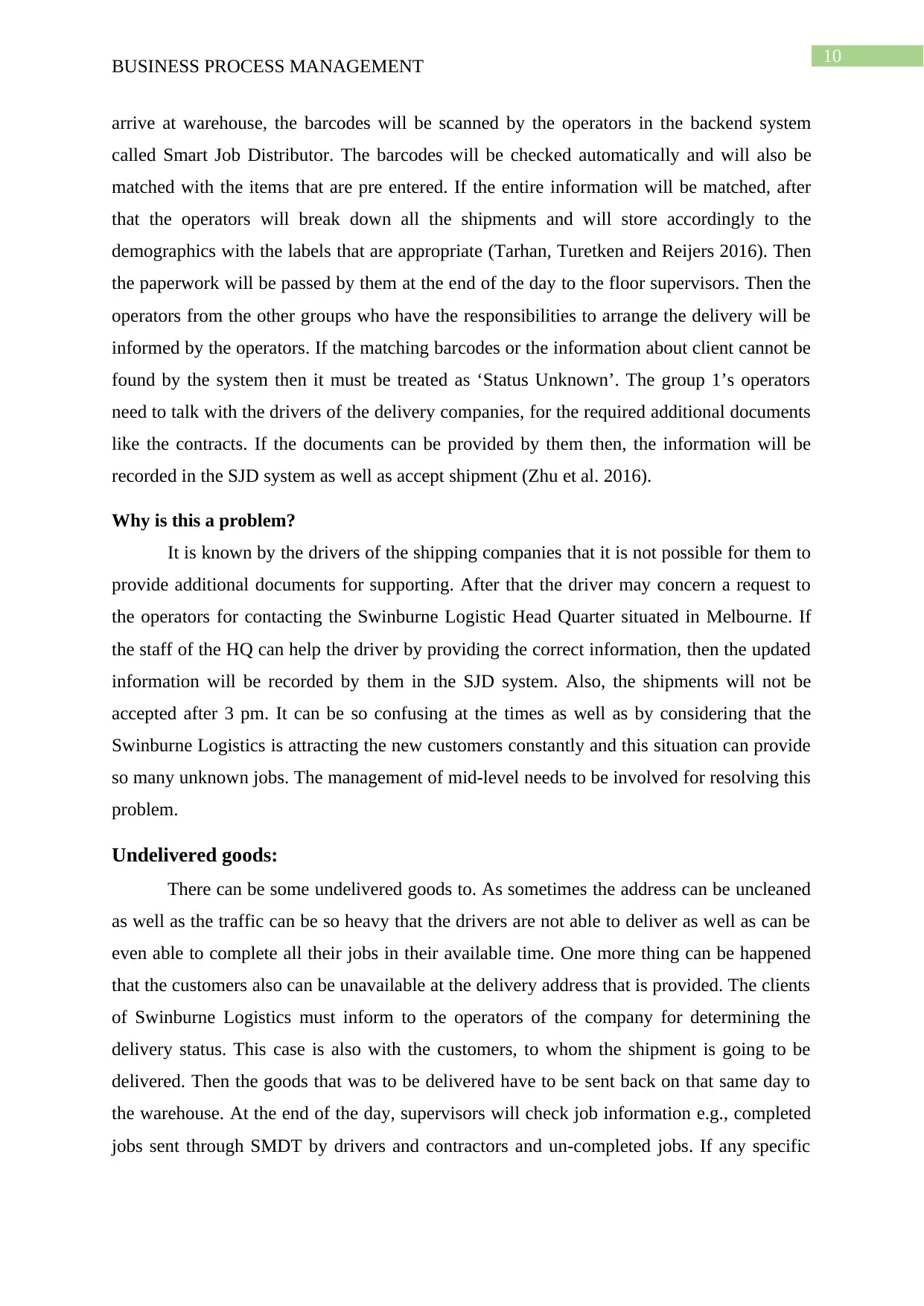
10
BUSINESS PROCESS MANAGEMENT
arrive at warehouse, the barcodes will be scanned by the operators in the backend system
called Smart Job Distributor. The barcodes will be checked automatically and will also be
matched with the items that are pre entered. If the entire information will be matched, after
that the operators will break down all the shipments and will store accordingly to the
demographics with the labels that are appropriate (Tarhan, Turetken and Reijers 2016). Then
the paperwork will be passed by them at the end of the day to the floor supervisors. Then the
operators from the other groups who have the responsibilities to arrange the delivery will be
informed by the operators. If the matching barcodes or the information about client cannot be
found by the system then it must be treated as ‘Status Unknown’. The group 1’s operators
need to talk with the drivers of the delivery companies, for the required additional documents
like the contracts. If the documents can be provided by them then, the information will be
recorded in the SJD system as well as accept shipment (Zhu et al. 2016).
Why is this a problem?
It is known by the drivers of the shipping companies that it is not possible for them to
provide additional documents for supporting. After that the driver may concern a request to
the operators for contacting the Swinburne Logistic Head Quarter situated in Melbourne. If
the staff of the HQ can help the driver by providing the correct information, then the updated
information will be recorded by them in the SJD system. Also, the shipments will not be
accepted after 3 pm. It can be so confusing at the times as well as by considering that the
Swinburne Logistics is attracting the new customers constantly and this situation can provide
so many unknown jobs. The management of mid-level needs to be involved for resolving this
problem.
Undelivered goods:
There can be some undelivered goods to. As sometimes the address can be uncleaned
as well as the traffic can be so heavy that the drivers are not able to deliver as well as can be
even able to complete all their jobs in their available time. One more thing can be happened
that the customers also can be unavailable at the delivery address that is provided. The clients
of Swinburne Logistics must inform to the operators of the company for determining the
delivery status. This case is also with the customers, to whom the shipment is going to be
delivered. Then the goods that was to be delivered have to be sent back on that same day to
the warehouse. At the end of the day, supervisors will check job information e.g., completed
jobs sent through SMDT by drivers and contractors and un-completed jobs. If any specific
BUSINESS PROCESS MANAGEMENT
arrive at warehouse, the barcodes will be scanned by the operators in the backend system
called Smart Job Distributor. The barcodes will be checked automatically and will also be
matched with the items that are pre entered. If the entire information will be matched, after
that the operators will break down all the shipments and will store accordingly to the
demographics with the labels that are appropriate (Tarhan, Turetken and Reijers 2016). Then
the paperwork will be passed by them at the end of the day to the floor supervisors. Then the
operators from the other groups who have the responsibilities to arrange the delivery will be
informed by the operators. If the matching barcodes or the information about client cannot be
found by the system then it must be treated as ‘Status Unknown’. The group 1’s operators
need to talk with the drivers of the delivery companies, for the required additional documents
like the contracts. If the documents can be provided by them then, the information will be
recorded in the SJD system as well as accept shipment (Zhu et al. 2016).
Why is this a problem?
It is known by the drivers of the shipping companies that it is not possible for them to
provide additional documents for supporting. After that the driver may concern a request to
the operators for contacting the Swinburne Logistic Head Quarter situated in Melbourne. If
the staff of the HQ can help the driver by providing the correct information, then the updated
information will be recorded by them in the SJD system. Also, the shipments will not be
accepted after 3 pm. It can be so confusing at the times as well as by considering that the
Swinburne Logistics is attracting the new customers constantly and this situation can provide
so many unknown jobs. The management of mid-level needs to be involved for resolving this
problem.
Undelivered goods:
There can be some undelivered goods to. As sometimes the address can be uncleaned
as well as the traffic can be so heavy that the drivers are not able to deliver as well as can be
even able to complete all their jobs in their available time. One more thing can be happened
that the customers also can be unavailable at the delivery address that is provided. The clients
of Swinburne Logistics must inform to the operators of the company for determining the
delivery status. This case is also with the customers, to whom the shipment is going to be
delivered. Then the goods that was to be delivered have to be sent back on that same day to
the warehouse. At the end of the day, supervisors will check job information e.g., completed
jobs sent through SMDT by drivers and contractors and un-completed jobs. If any specific
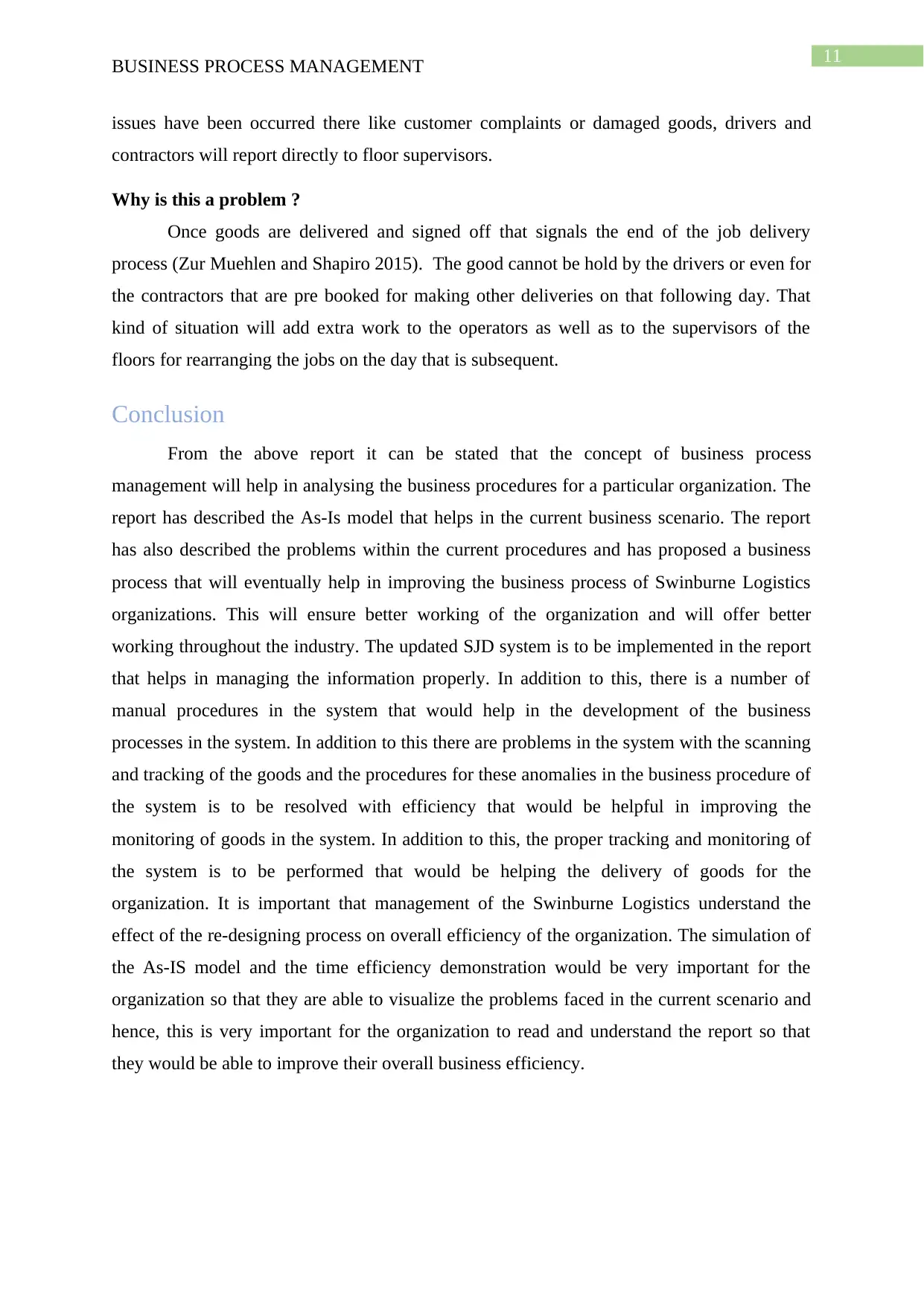
11
BUSINESS PROCESS MANAGEMENT
issues have been occurred there like customer complaints or damaged goods, drivers and
contractors will report directly to floor supervisors.
Why is this a problem ?
Once goods are delivered and signed off that signals the end of the job delivery
process (Zur Muehlen and Shapiro 2015). The good cannot be hold by the drivers or even for
the contractors that are pre booked for making other deliveries on that following day. That
kind of situation will add extra work to the operators as well as to the supervisors of the
floors for rearranging the jobs on the day that is subsequent.
Conclusion
From the above report it can be stated that the concept of business process
management will help in analysing the business procedures for a particular organization. The
report has described the As-Is model that helps in the current business scenario. The report
has also described the problems within the current procedures and has proposed a business
process that will eventually help in improving the business process of Swinburne Logistics
organizations. This will ensure better working of the organization and will offer better
working throughout the industry. The updated SJD system is to be implemented in the report
that helps in managing the information properly. In addition to this, there is a number of
manual procedures in the system that would help in the development of the business
processes in the system. In addition to this there are problems in the system with the scanning
and tracking of the goods and the procedures for these anomalies in the business procedure of
the system is to be resolved with efficiency that would be helpful in improving the
monitoring of goods in the system. In addition to this, the proper tracking and monitoring of
the system is to be performed that would be helping the delivery of goods for the
organization. It is important that management of the Swinburne Logistics understand the
effect of the re-designing process on overall efficiency of the organization. The simulation of
the As-IS model and the time efficiency demonstration would be very important for the
organization so that they are able to visualize the problems faced in the current scenario and
hence, this is very important for the organization to read and understand the report so that
they would be able to improve their overall business efficiency.
BUSINESS PROCESS MANAGEMENT
issues have been occurred there like customer complaints or damaged goods, drivers and
contractors will report directly to floor supervisors.
Why is this a problem ?
Once goods are delivered and signed off that signals the end of the job delivery
process (Zur Muehlen and Shapiro 2015). The good cannot be hold by the drivers or even for
the contractors that are pre booked for making other deliveries on that following day. That
kind of situation will add extra work to the operators as well as to the supervisors of the
floors for rearranging the jobs on the day that is subsequent.
Conclusion
From the above report it can be stated that the concept of business process
management will help in analysing the business procedures for a particular organization. The
report has described the As-Is model that helps in the current business scenario. The report
has also described the problems within the current procedures and has proposed a business
process that will eventually help in improving the business process of Swinburne Logistics
organizations. This will ensure better working of the organization and will offer better
working throughout the industry. The updated SJD system is to be implemented in the report
that helps in managing the information properly. In addition to this, there is a number of
manual procedures in the system that would help in the development of the business
processes in the system. In addition to this there are problems in the system with the scanning
and tracking of the goods and the procedures for these anomalies in the business procedure of
the system is to be resolved with efficiency that would be helpful in improving the
monitoring of goods in the system. In addition to this, the proper tracking and monitoring of
the system is to be performed that would be helping the delivery of goods for the
organization. It is important that management of the Swinburne Logistics understand the
effect of the re-designing process on overall efficiency of the organization. The simulation of
the As-IS model and the time efficiency demonstration would be very important for the
organization so that they are able to visualize the problems faced in the current scenario and
hence, this is very important for the organization to read and understand the report so that
they would be able to improve their overall business efficiency.
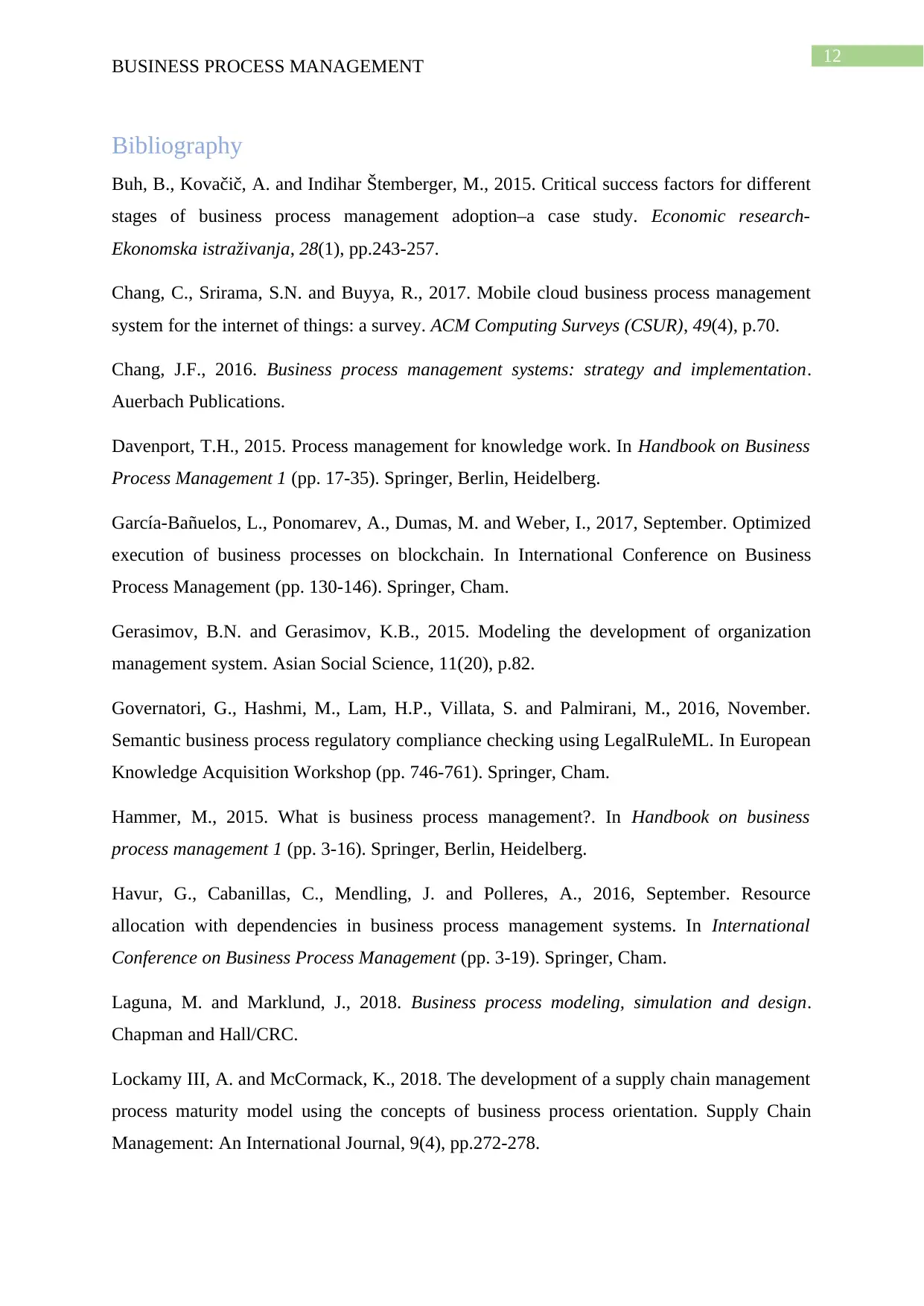
12
BUSINESS PROCESS MANAGEMENT
Bibliography
Buh, B., Kovačič, A. and Indihar Štemberger, M., 2015. Critical success factors for different
stages of business process management adoption–a case study. Economic research-
Ekonomska istraživanja, 28(1), pp.243-257.
Chang, C., Srirama, S.N. and Buyya, R., 2017. Mobile cloud business process management
system for the internet of things: a survey. ACM Computing Surveys (CSUR), 49(4), p.70.
Chang, J.F., 2016. Business process management systems: strategy and implementation.
Auerbach Publications.
Davenport, T.H., 2015. Process management for knowledge work. In Handbook on Business
Process Management 1 (pp. 17-35). Springer, Berlin, Heidelberg.
García-Bañuelos, L., Ponomarev, A., Dumas, M. and Weber, I., 2017, September. Optimized
execution of business processes on blockchain. In International Conference on Business
Process Management (pp. 130-146). Springer, Cham.
Gerasimov, B.N. and Gerasimov, K.B., 2015. Modeling the development of organization
management system. Asian Social Science, 11(20), p.82.
Governatori, G., Hashmi, M., Lam, H.P., Villata, S. and Palmirani, M., 2016, November.
Semantic business process regulatory compliance checking using LegalRuleML. In European
Knowledge Acquisition Workshop (pp. 746-761). Springer, Cham.
Hammer, M., 2015. What is business process management?. In Handbook on business
process management 1 (pp. 3-16). Springer, Berlin, Heidelberg.
Havur, G., Cabanillas, C., Mendling, J. and Polleres, A., 2016, September. Resource
allocation with dependencies in business process management systems. In International
Conference on Business Process Management (pp. 3-19). Springer, Cham.
Laguna, M. and Marklund, J., 2018. Business process modeling, simulation and design.
Chapman and Hall/CRC.
Lockamy III, A. and McCormack, K., 2018. The development of a supply chain management
process maturity model using the concepts of business process orientation. Supply Chain
Management: An International Journal, 9(4), pp.272-278.
BUSINESS PROCESS MANAGEMENT
Bibliography
Buh, B., Kovačič, A. and Indihar Štemberger, M., 2015. Critical success factors for different
stages of business process management adoption–a case study. Economic research-
Ekonomska istraživanja, 28(1), pp.243-257.
Chang, C., Srirama, S.N. and Buyya, R., 2017. Mobile cloud business process management
system for the internet of things: a survey. ACM Computing Surveys (CSUR), 49(4), p.70.
Chang, J.F., 2016. Business process management systems: strategy and implementation.
Auerbach Publications.
Davenport, T.H., 2015. Process management for knowledge work. In Handbook on Business
Process Management 1 (pp. 17-35). Springer, Berlin, Heidelberg.
García-Bañuelos, L., Ponomarev, A., Dumas, M. and Weber, I., 2017, September. Optimized
execution of business processes on blockchain. In International Conference on Business
Process Management (pp. 130-146). Springer, Cham.
Gerasimov, B.N. and Gerasimov, K.B., 2015. Modeling the development of organization
management system. Asian Social Science, 11(20), p.82.
Governatori, G., Hashmi, M., Lam, H.P., Villata, S. and Palmirani, M., 2016, November.
Semantic business process regulatory compliance checking using LegalRuleML. In European
Knowledge Acquisition Workshop (pp. 746-761). Springer, Cham.
Hammer, M., 2015. What is business process management?. In Handbook on business
process management 1 (pp. 3-16). Springer, Berlin, Heidelberg.
Havur, G., Cabanillas, C., Mendling, J. and Polleres, A., 2016, September. Resource
allocation with dependencies in business process management systems. In International
Conference on Business Process Management (pp. 3-19). Springer, Cham.
Laguna, M. and Marklund, J., 2018. Business process modeling, simulation and design.
Chapman and Hall/CRC.
Lockamy III, A. and McCormack, K., 2018. The development of a supply chain management
process maturity model using the concepts of business process orientation. Supply Chain
Management: An International Journal, 9(4), pp.272-278.
Paraphrase This Document
Need a fresh take? Get an instant paraphrase of this document with our AI Paraphraser
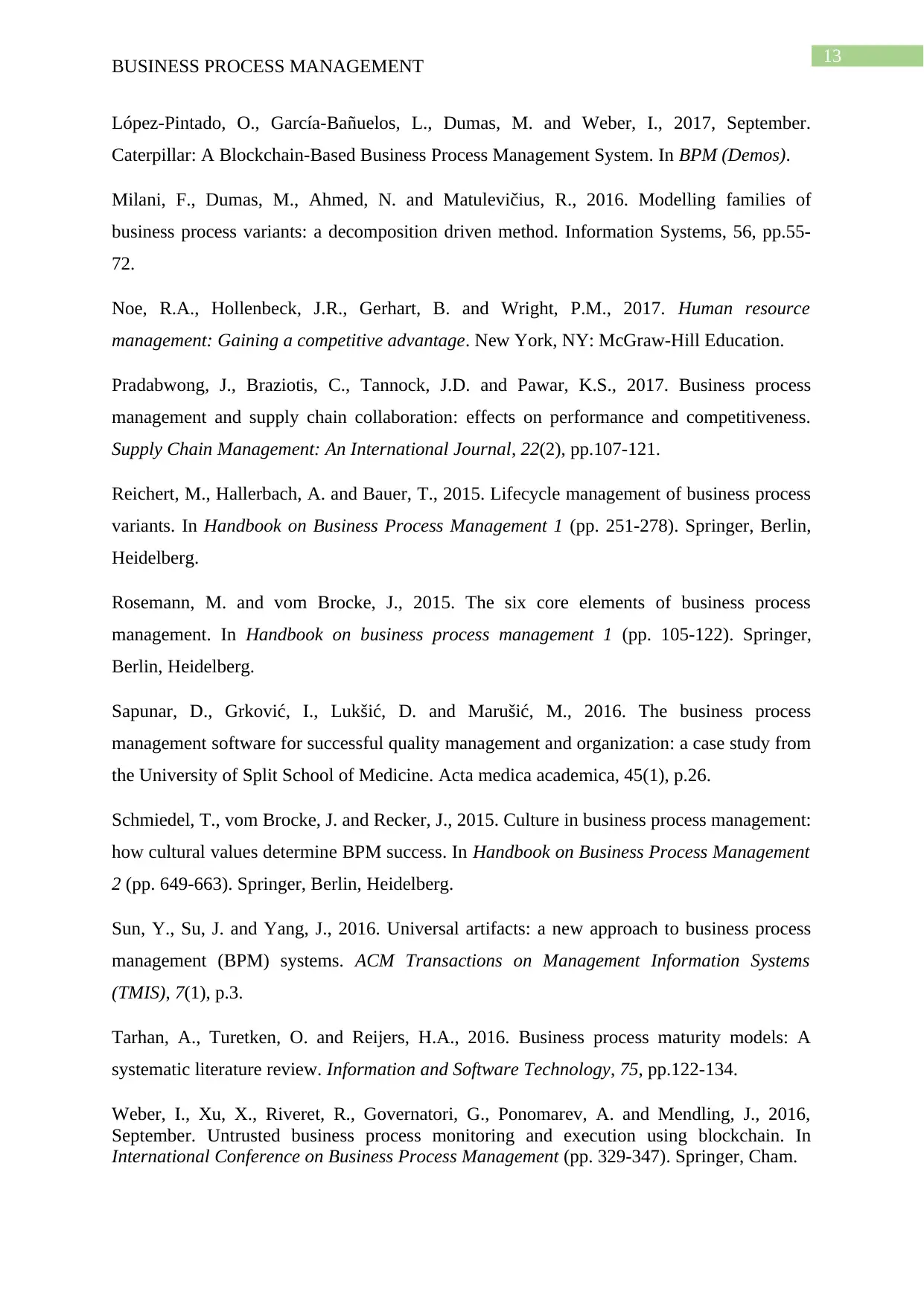
13
BUSINESS PROCESS MANAGEMENT
López-Pintado, O., García-Bañuelos, L., Dumas, M. and Weber, I., 2017, September.
Caterpillar: A Blockchain-Based Business Process Management System. In BPM (Demos).
Milani, F., Dumas, M., Ahmed, N. and Matulevičius, R., 2016. Modelling families of
business process variants: a decomposition driven method. Information Systems, 56, pp.55-
72.
Noe, R.A., Hollenbeck, J.R., Gerhart, B. and Wright, P.M., 2017. Human resource
management: Gaining a competitive advantage. New York, NY: McGraw-Hill Education.
Pradabwong, J., Braziotis, C., Tannock, J.D. and Pawar, K.S., 2017. Business process
management and supply chain collaboration: effects on performance and competitiveness.
Supply Chain Management: An International Journal, 22(2), pp.107-121.
Reichert, M., Hallerbach, A. and Bauer, T., 2015. Lifecycle management of business process
variants. In Handbook on Business Process Management 1 (pp. 251-278). Springer, Berlin,
Heidelberg.
Rosemann, M. and vom Brocke, J., 2015. The six core elements of business process
management. In Handbook on business process management 1 (pp. 105-122). Springer,
Berlin, Heidelberg.
Sapunar, D., Grković, I., Lukšić, D. and Marušić, M., 2016. The business process
management software for successful quality management and organization: a case study from
the University of Split School of Medicine. Acta medica academica, 45(1), p.26.
Schmiedel, T., vom Brocke, J. and Recker, J., 2015. Culture in business process management:
how cultural values determine BPM success. In Handbook on Business Process Management
2 (pp. 649-663). Springer, Berlin, Heidelberg.
Sun, Y., Su, J. and Yang, J., 2016. Universal artifacts: a new approach to business process
management (BPM) systems. ACM Transactions on Management Information Systems
(TMIS), 7(1), p.3.
Tarhan, A., Turetken, O. and Reijers, H.A., 2016. Business process maturity models: A
systematic literature review. Information and Software Technology, 75, pp.122-134.
Weber, I., Xu, X., Riveret, R., Governatori, G., Ponomarev, A. and Mendling, J., 2016,
September. Untrusted business process monitoring and execution using blockchain. In
International Conference on Business Process Management (pp. 329-347). Springer, Cham.
BUSINESS PROCESS MANAGEMENT
López-Pintado, O., García-Bañuelos, L., Dumas, M. and Weber, I., 2017, September.
Caterpillar: A Blockchain-Based Business Process Management System. In BPM (Demos).
Milani, F., Dumas, M., Ahmed, N. and Matulevičius, R., 2016. Modelling families of
business process variants: a decomposition driven method. Information Systems, 56, pp.55-
72.
Noe, R.A., Hollenbeck, J.R., Gerhart, B. and Wright, P.M., 2017. Human resource
management: Gaining a competitive advantage. New York, NY: McGraw-Hill Education.
Pradabwong, J., Braziotis, C., Tannock, J.D. and Pawar, K.S., 2017. Business process
management and supply chain collaboration: effects on performance and competitiveness.
Supply Chain Management: An International Journal, 22(2), pp.107-121.
Reichert, M., Hallerbach, A. and Bauer, T., 2015. Lifecycle management of business process
variants. In Handbook on Business Process Management 1 (pp. 251-278). Springer, Berlin,
Heidelberg.
Rosemann, M. and vom Brocke, J., 2015. The six core elements of business process
management. In Handbook on business process management 1 (pp. 105-122). Springer,
Berlin, Heidelberg.
Sapunar, D., Grković, I., Lukšić, D. and Marušić, M., 2016. The business process
management software for successful quality management and organization: a case study from
the University of Split School of Medicine. Acta medica academica, 45(1), p.26.
Schmiedel, T., vom Brocke, J. and Recker, J., 2015. Culture in business process management:
how cultural values determine BPM success. In Handbook on Business Process Management
2 (pp. 649-663). Springer, Berlin, Heidelberg.
Sun, Y., Su, J. and Yang, J., 2016. Universal artifacts: a new approach to business process
management (BPM) systems. ACM Transactions on Management Information Systems
(TMIS), 7(1), p.3.
Tarhan, A., Turetken, O. and Reijers, H.A., 2016. Business process maturity models: A
systematic literature review. Information and Software Technology, 75, pp.122-134.
Weber, I., Xu, X., Riveret, R., Governatori, G., Ponomarev, A. and Mendling, J., 2016,
September. Untrusted business process monitoring and execution using blockchain. In
International Conference on Business Process Management (pp. 329-347). Springer, Cham.
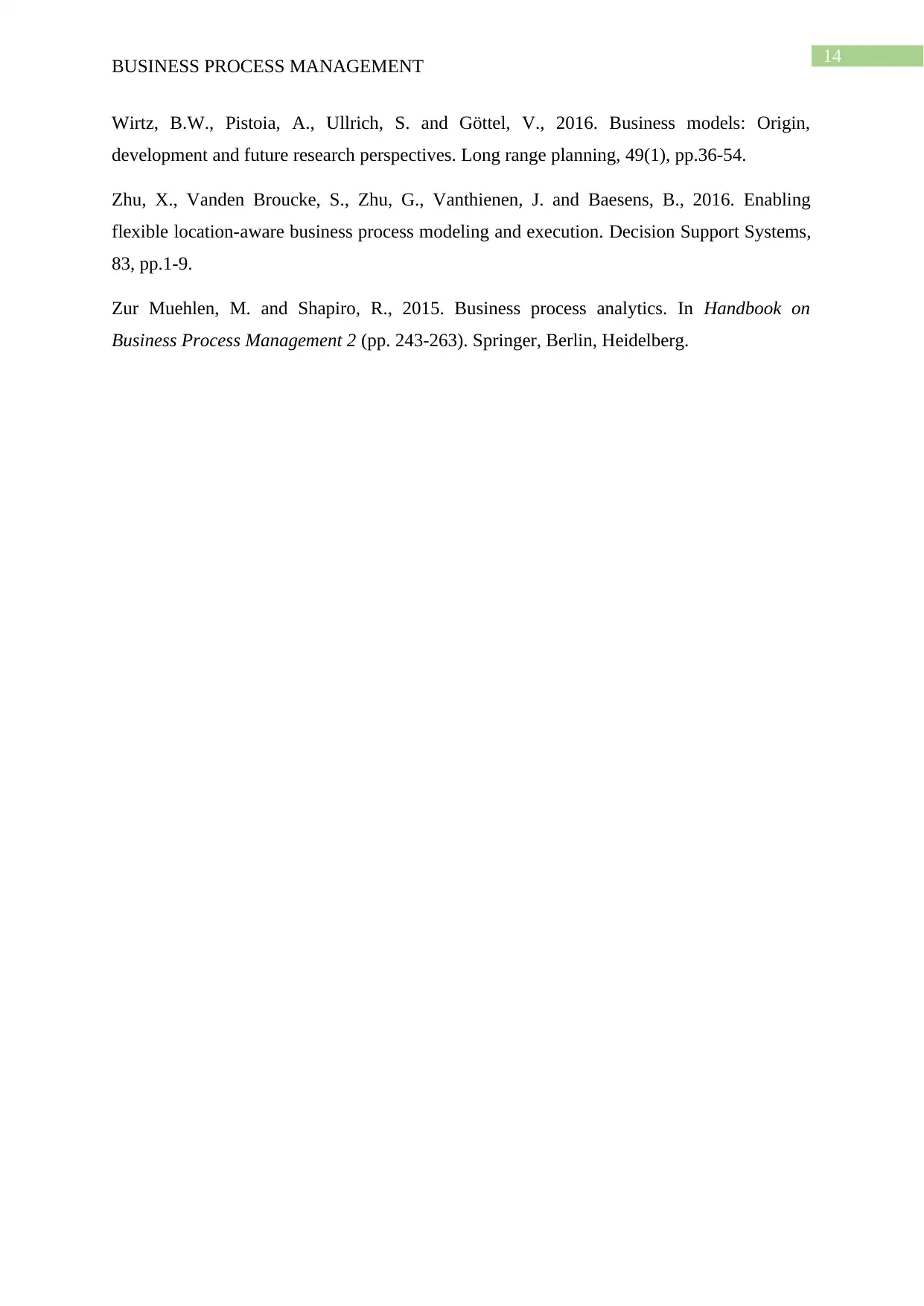
14
BUSINESS PROCESS MANAGEMENT
Wirtz, B.W., Pistoia, A., Ullrich, S. and Göttel, V., 2016. Business models: Origin,
development and future research perspectives. Long range planning, 49(1), pp.36-54.
Zhu, X., Vanden Broucke, S., Zhu, G., Vanthienen, J. and Baesens, B., 2016. Enabling
flexible location-aware business process modeling and execution. Decision Support Systems,
83, pp.1-9.
Zur Muehlen, M. and Shapiro, R., 2015. Business process analytics. In Handbook on
Business Process Management 2 (pp. 243-263). Springer, Berlin, Heidelberg.
BUSINESS PROCESS MANAGEMENT
Wirtz, B.W., Pistoia, A., Ullrich, S. and Göttel, V., 2016. Business models: Origin,
development and future research perspectives. Long range planning, 49(1), pp.36-54.
Zhu, X., Vanden Broucke, S., Zhu, G., Vanthienen, J. and Baesens, B., 2016. Enabling
flexible location-aware business process modeling and execution. Decision Support Systems,
83, pp.1-9.
Zur Muehlen, M. and Shapiro, R., 2015. Business process analytics. In Handbook on
Business Process Management 2 (pp. 243-263). Springer, Berlin, Heidelberg.
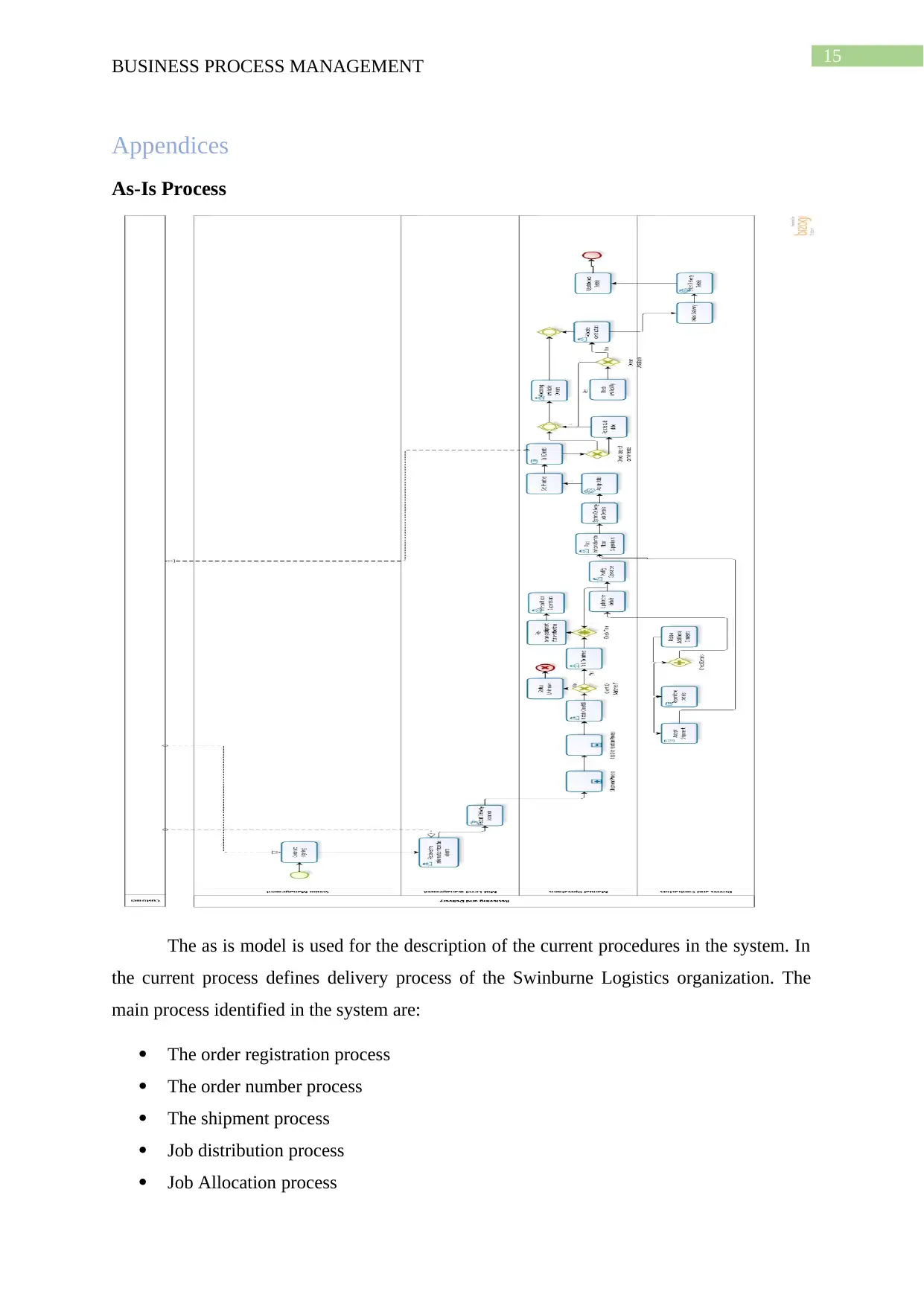
15
BUSINESS PROCESS MANAGEMENT
Appendices
As-Is Process
The as is model is used for the description of the current procedures in the system. In
the current process defines delivery process of the Swinburne Logistics organization. The
main process identified in the system are:
The order registration process
The order number process
The shipment process
Job distribution process
Job Allocation process
BUSINESS PROCESS MANAGEMENT
Appendices
As-Is Process
The as is model is used for the description of the current procedures in the system. In
the current process defines delivery process of the Swinburne Logistics organization. The
main process identified in the system are:
The order registration process
The order number process
The shipment process
Job distribution process
Job Allocation process
Secure Best Marks with AI Grader
Need help grading? Try our AI Grader for instant feedback on your assignments.
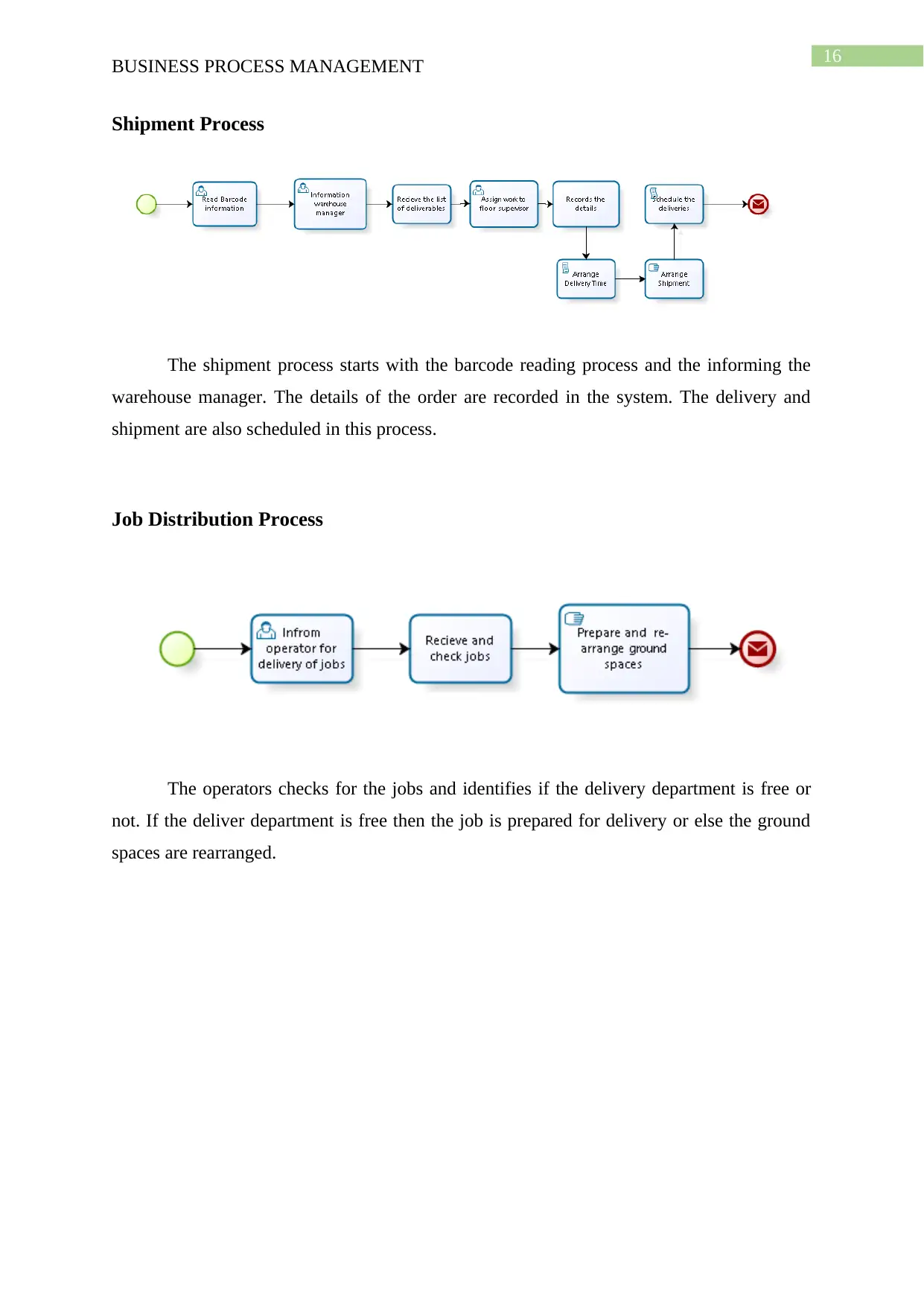
16
BUSINESS PROCESS MANAGEMENT
Shipment Process
The shipment process starts with the barcode reading process and the informing the
warehouse manager. The details of the order are recorded in the system. The delivery and
shipment are also scheduled in this process.
Job Distribution Process
The operators checks for the jobs and identifies if the delivery department is free or
not. If the deliver department is free then the job is prepared for delivery or else the ground
spaces are rearranged.
BUSINESS PROCESS MANAGEMENT
Shipment Process
The shipment process starts with the barcode reading process and the informing the
warehouse manager. The details of the order are recorded in the system. The delivery and
shipment are also scheduled in this process.
Job Distribution Process
The operators checks for the jobs and identifies if the delivery department is free or
not. If the deliver department is free then the job is prepared for delivery or else the ground
spaces are rearranged.
1 out of 17
Related Documents
Your All-in-One AI-Powered Toolkit for Academic Success.
+13062052269
info@desklib.com
Available 24*7 on WhatsApp / Email
![[object Object]](/_next/static/media/star-bottom.7253800d.svg)
Unlock your academic potential
© 2024 | Zucol Services PVT LTD | All rights reserved.





